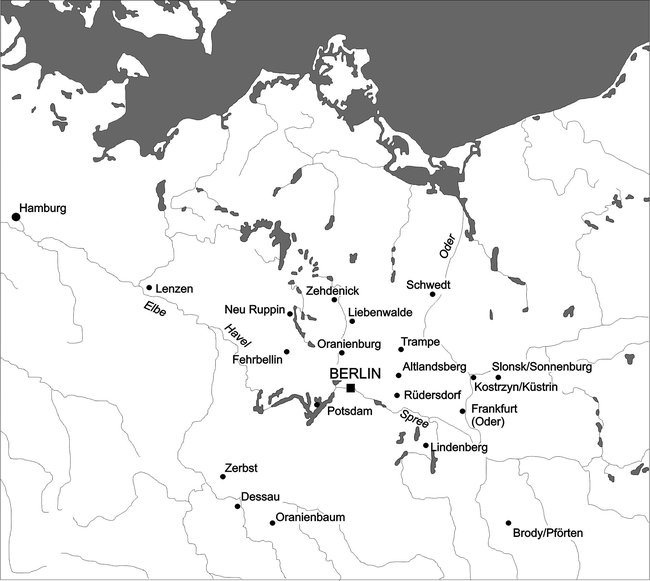5.1 Friedrich Wilhelm, Brandenburg and the Netherlands
In 1648 Brandenburg’s territory was crumbled and ruined.1 At the beginning of the Thirty Years’ War, 30 years earlier, Lutheran Brandenburg had tried to refrain from the conflict. But it was unlucky to be situated in between the territories of Habsburg and Sweden, so it had been used as a battle field, winter quarters and plundering area [1].2 After the peace, in October 1648, Friedrich Wilhelm (1620-1688) [2] decided to make an inventory of the situation in his country. Fifty to 60% of the population had died or fled. In Frankfurt an der Oder the population number had decreased from around 13,000 before 1618, to 2,366 in 1653. Out of 251 villages that were visited, four were completely destroyed, and in 44 of them in total only lived 75 farmers.3 In Neuruppin, north of Berlin, 600 out of 3,500 inhabitants remained. Berlin had lost ‘only’ a quarter of its inhabitants, but more than a third of its houses stood empty and many buildings were dilapidated.4 The old Hohenzollern palace, dating back to 1442, was in a poor state.5 In the 16th century it had been reshaped in a renaissance building but since then hardly anything had been done to keep it in shape.
During his reign, 1648-1688, Elector Friedrich Wilhelm was continuously working on the restoration and modernisation of Brandenburg.6 In 1634, at an age of 14, he was sent to the Dutch Republic for education. Friedrich Wilhelm paid visits to his future father-in-law Frederik Hendrik in The Hague, to Amsterdam, and got acquainted with Johan Maurits van Nassau-Siegen (1604-1679) [3], who was to play a leading role in his rebuilding policy for Brandenburg 20 years later.
During the Thirty Years’ War, not less than 27% of the students at Leiden University were of German origin.7 The intellectual climate was a catalyst for theoretic based influence and the Brandenburg intellectual milieu in the second half of the 17th century was deeply influenced by the Dutch.8 In matters of architecture, fortification and mathematics, the lectures of Nicolaus Goldmann drew a lot of foreign students to Leiden.
As he returned to Brandenburg in 1638, Friedrich Wilhelm was for ever impressed by the prosperity of the Dutch Republic.9 In 1640 he succeeded his father as elector. In 1646, he married the Dutch princess Louise Henriette, the eldest daughter of Frederik Hendrik. One of his agents that kept him informed about the situation in the Republic was Matthias Dögen (1605-1672), who was appointed resident of the elector in 1647. Matthias Dögen had studied in Frankfurt an der Oder and afterwards in Leiden where he attended the Duytsche Mathematique. Like his fellow agents he reported about political issues, cultural matters and sent books, prints and art and he as well sent art objects and craftsmen to Brandenburg.

1
The east of Germany with most of the in the text mentioned towns and villages (drawing by author)

2
François Dieussart
Portrait of Friedrich Wilhelm von Brandenburg (1620-1688), dated 1652
Oranienburg, Schlossmuseum Oranienburg

3
Pieter Nason
Portrait of Johan Maurits van Nassau-Siegen (1604-1679) as a knight of the order of Saint John of Jerusalem, dated 1666
Warsaw, Muzeum Narodowe w Warszawie, inv./cat.nr. M.Ob.527 MNW
Notes
1 This contribution is an adapted and shortened version of an earlier paper: Van Tussenbroek 2013.
2 Schmidt 1999; Opgenoorth 1971; Materna/Ribbe 1995, p. 290ff.
3 Materna/Ribbe 1995, p. 306.
4 See for the history of Berlin: Escher 1998; Ribbe 1998.
5 Geyer 1936; Peschken/Klünner 1982 and Wiesinger 1989.
6 Baumgart 1990, p. 41.
7 Schneppen 1960; Oestreich 1968, p. 14-16 and Beuys 1980, p. 47-48.
8 Oudesluijs 1994, p. 17; also Griesa 1994, p. 31-33 and Oestreich 1968.
9 Van den Heuvel 1994; Goudeau 1995 and Goudeau 2005.
10 Oestreich 1968, p. 6-13; Van Gelderen 1994. Also Upmark 1900 and Bientjes 1967, p. 161-182.

